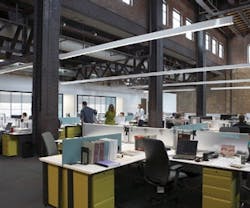St. Louis Conversion Captures LEED Gold
CITATION of EXCELLENCE: GREEN FACILITIES
Power House, St. Louis
Back
to Project Innovations introduction
See products used in this project
In its quest for new offices, Cannon Design wanted something unique – an opportunity to flex its design muscle, and a place to reinvent how it practices. And St. Louis’ Power House delivered.
The 19,000-square-foot landmark, constructed in 1928, once provided coal-fired heat. The property, marked by tall, arched windows, stood empty since 1980. “It had lots of people’s hearts, but no one could figure out what to do with it,” comments Thomas Bergmann, Cannon Design’s project principal.
Bergmann likens the job to building a ship in a bottle. An interior 3-story gallery was formed by constructing two partial levels. Those, combined with two existing floors and a rooftop penthouse, yielded 32,000 square feet of space. New floors were set back from the windows to maintain the sense of transparency and volume of the original building.
The space fits Cannon’s needs perfectly. Large, complex commissions with aggressive schedules require interdisciplinary collaboration, and the open landscape with multiple gathering spots now allows for impromptu gatherings.
Given Cannon’s desire for LEED certification (it recently earned LEED Gold), the project wasn’t without challenges, including removing toxic pigeon droppings and lead paint on the steel truss work.
Cannon attained LEED Gold not through gee-whiz technology, but by executing small moves, such as specifying building materials with recycled content, providing daylight to 75 percent of interior spaces, choosing low-VOC paints, and converting a former coal yard into a native plant garden.
The building now serves as a marketing tool for the firm and illustrates how a green building can feel. “When you walk in, you don’t sense that we’re growing our own corn,” jokes Bergmann. “We can show clients that they don’t have to sacrifice quality of space or excellent design for sustainability.”
